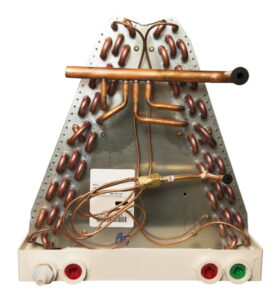
A well-installed air conditioning system from a trusted manufacturer that receives annual maintenance should run into few repair needs during its service life. But nothing can prevent all AC malfunctions, and one particular problem homeowners may encounter is an AC leaking refrigerant. Even a small leak can spell big trouble for an air conditioner—if not repaired, loss of refrigerant in an AC will eventually cause the system to break down and need a replacement.
Below we’ll look closer at the trouble with refrigerant leaks and how you can detect them early enough so you can call us for the air conditioning service in Conway, AR that will keep your comfort system working.
Refrigerant in the AC
People often have a misconception that refrigerant gets used up in an air conditioning system and will need a refill at some point. But refrigerant doesn’t work as an energy source for an AC; it does the job of heat transfer, shifting between gas and liquid states to allow the air conditioner to move heat from inside the house to outside the house. Unless leaks start, the refrigerant level in an air conditioning system will remain at the same level (or charge) for its entire service life.
Any air conditioner is built for a specific charge. If the charge drops or too much is put in, it changes the pressure throughout the air conditioner, and leads to…
- An increase in indoor humidity
- A rise in the cost to run the AC as efficiency drops
- A decline in cooling capacity
- An overheated compressor that burns out, which usually means the whole AC must be replaced
As you can see, you don’t want to wait to schedule this AC repair. If you think your air conditioner has refrigerant leaks, call us right away!
How You Can Tell If Your AC Has Leaks
Leaks in an AC are often tiny, but they’re enough to start trouble. You can watch for several signs of a drop in the air conditioner’s refrigerant charge. Some of these may indicate other problems, but you’ll still want those repaired.
- A bubbling sound from the indoor cabinet: One spot where refrigerant leaks often start is along the indoor evaporator coil. Tiny pinhole leaks will let the cold liquid refrigerant escape, creating a bubbling sound. If you hear this sound, take a look at the coils. You may notice small bubbles appearing. This is a leak! Shut off the AC and call for assistance.
- A hissing sound from the outdoor cabinet: If leaks occur along the outdoor condenser coil, it will create a hissing sound as the high-pressure hot gas from the refrigerant begins to escape.
- Ice on the evaporator coil: No, you should never see ice on the coil, or anywhere else on the AC. Ice on the coil means for some reason it isn’t absorbing enough heat, which could be due to loss of refrigerant. Whatever the cause, this requires calling for technicians.
- Changes in humidity: Although the AC will start to lose cooling capacity because of a drop in refrigerant, you’re more likely to notice a rise in indoor humidity first.
- Short-cycling: This refers to when the AC starts and stops repeatedly over a short time. Refrigerant leaks are only one potential cause, but you need to stop the short-cycling as soon as possible. Call for expert repairs.
Dewees HVAC is here to keep you comfortable! Schedule AC repairs with our team.
